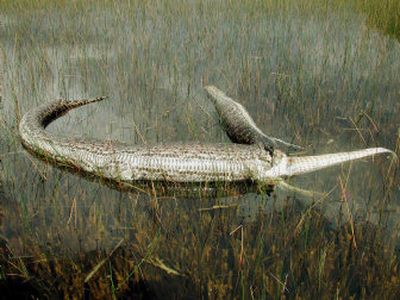Python, gator tangle in the Everglades; neither survives

MIAMI – A meeting between two of the largest and fiercest predators in the Everglades – a Burmese python and an American alligator – ended in a scene as rare as it was bizarre.
The 13-foot-snake and 6-foot gator both wound up dead, locked so gruesomely it is hard to make heads, tails or any other body part of either creature.
When the carcasses were found last week in an isolated marsh in Everglades National Park, the gator’s tail and hind legs protruded from the ruptured gut of a python – which had swallowed it whole.
As an added touch of the macabre, the snake’s head was missing.
For scientists, exactly how the clash occurred is a compelling curiosity. More importantly, the latest and most extraordinary encounter provides disturbing evidence that giant exotic snakes, which can top 20 feet in length and kill by squeezing the life out of prey, have not only invaded the Everglades but also could challenge the native gator for a perch atop the food chain.
“It’s just off-the-charts absurd to think that this kind of animal, a significant top-of-the-pyramid kind of predator in its native land, is trying to make a living in South Florida,” said park biologist Skip Snow, who has been tracking the spread of the snakes.
Pythons, likely abandoned by pet owners, have been seen in the Everglades since the 1980s. But in the past two years alone, Snow has documented 156 python captures, a surge that has convinced biologists the snakes are multiplying in the wild.
The growing population of big, scary predators also raises questions about threats to native species and whether anything indigenous – gators, for starters – might be capable of consuming and potentially controlling one of the world’s largest snake species.
The latest find was spotted floating in a spike rush marsh in the Shark River Slough on Sept. 26 by Michael Barron, a helicopter pilot. It was examined the next day by Snow.
The discovery confirmed that snakes and gators, while typically consuming less troublesome mammals, turtles and birds, have an appetite for each other – at least when the opportunity presents itself.
The first observed encounter in the park occurred three years ago when awestruck onlookers at the popular Anhinga Trail boardwalk witnessed a tussle between a 10- to 15-foot snake and 6- to 9-foot gator. That fight, which lasted an estimated 24 hours, ended in an apparent draw, with both swimming off and vanishing.
Such clashes, though spawned by damaging incursion by an exotic species, can’t help but fascinate both the public and scientists, said Frank Mazzotti, a University of Florida wildlife professor. Mazzotti said size would probably dictate which species would win most encounters.